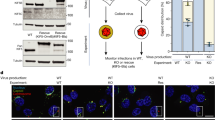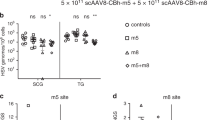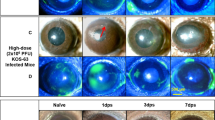Abstract
It has been amply documented that herpes simplex virus (HSV) persists in sensory ganglia of the peripheral nervous system (PNS)1–5. In contrast, HSV latency in the central nervous system (CNS) has not been well characterized. Corneal inoculation of virus results in a productive viral infection in the CNS during the first week after inoculation6, Indicating that the virus can progress from the PNS to the CNS. During latency, HSV has been found by co-cultivation of CNS tissue in only a very small fraction of inoculated mice7,8. We have used here molecular hybridization techniques to analyse the fate of viruses that reach the CNS by anatomical pathways. We show that 6 days after corneal inoculation of HSV-1 a productive viral infection was present in brain tissue as well as in peripheral ganglia in at least 90% of the inoculated mice. The mortality during this acute phase was only 2%. In the survivors, latent HSV could be recovered by explantation from 95% of the trigeminal ganglia, but only 5% of the brain tissue expiants of the same mice yielded infectious virus. However, HSV DNA sequences were detected in the brains of 30% of mice which harboured latent HSV in their trigeminal ganglia. These results suggest that viruses that progress from the PNS into the CNS are not eliminated, but are capable of establishing a latent infection in the CNS that cannot be reactivated by explantation techniques.
This is a preview of subscription content, access via your institution
Access options
Subscribe to this journal
Receive 51 print issues and online access
$199.00 per year
only $3.90 per issue
Buy this article
- Purchase on Springer Link
- Instant access to full article PDF
Prices may be subject to local taxes which are calculated during checkout
Similar content being viewed by others
References
Stevens, J. G. & Cook, M. L. Science 173, 843 (1971).
Price, R. W., Katz, B. J. & Notkins, A. L. Nature 257, 686 (1975).
Walz, M. A., Price, R. W. & Notkins, A. L. Science 184, 1185 (1974).
Puga, A., Rosenthal, J. D., Openshaw, H. & Notkins, A. L. Virology 89, 102 (1978).
Openshaw, H., Asher, L. S. V., Wohlenberg, C., Sekizawa, T. & Notkins, A. L. J. gen. Virol. 44, 205 (1979).
Baringer, J. R. & Griffith, J. F. J. Neuropath. exp. Neurol. 29, 89 (1970).
Knotts, E. P., Cook, M. L. & Stevens, J. G. J. exp. Med. 138, 740 (1973).
Cook, M. L. & Stevens, J. G. J. gen. Virol. 31, 75 (1976).
Maniatis, T., Jeffrey, A. & Kleid, D. G. Proc. natn. Acad. Sci. U.S.A. 72, 1184 (1975).
Britten, R. J., Graham, D. E. & Neufeld, B. B. Meth. Enzym. 29, 363 (1974).
Kohne, D. E. Biophys. J. 8, 1104 (1968).
Britten, R. J. & Smith, J. Yb. Carnegie Instn Wash. 68, 378 (1970).
Hill, T. J., Field, H. J. & Roome, A. P. C. J. gen Virol. 15, 253 (1972).
Cook, M. L. & Stevens, J. G. Infect. Immun. 7, 272 (1973).
Baringer, J. R. & Swoveland, P. Lab. Invest. 30, 230 (1974).
Author information
Authors and Affiliations
Rights and permissions
About this article
Cite this article
Cabrera, C., Wohlenberg, C., Openshaw, H. et al. Herpes simplex virus DNA sequences in the CNS of latently infected mice. Nature 288, 288–290 (1980). https://doi.org/10.1038/288288a0
Received:
Accepted:
Issue Date:
DOI: https://doi.org/10.1038/288288a0
This article is cited by
-
An intact complement system dampens cornea inflammation during acute primary HSV-1 infection
Scientific Reports (2021)
-
Autophagy during viral infection — a double-edged sword
Nature Reviews Microbiology (2018)
-
Reactivation of HSV-1 following explant of tree shrew brain
Journal of NeuroVirology (2016)
-
A NK complex‐linked locus restricts the spread of herpes simplex virus type 1 in the brains of C57BL/6 mice
Immunology & Cell Biology (2015)
-
Latency associated promoter transgene expression in the central nervous system after stereotaxic delivery of replication-defective HSV-1-based vectors
Gene Therapy (2001)
Comments
By submitting a comment you agree to abide by our Terms and Community Guidelines. If you find something abusive or that does not comply with our terms or guidelines please flag it as inappropriate.



